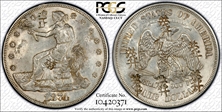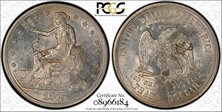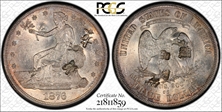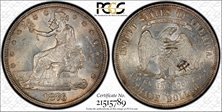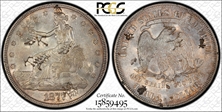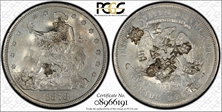Interesting Duplicates 的钱币相册
The 73-P is one of the most difficult Trade Dollars to find chopmarked. On the obverse are two carefully placed chops: the first one is "wang" which can be translated into "king;" the second one "feng" which can mean "seal." An intriguing combination! This coin has been owned by a number of prominent Trade Dollar collectors over the years. I am very happy to have it leading off my collection.
ex-Rose. Frank Rose was the godfather of chopmark collecting and wrote the standard book "Chopmarks."
One faint chopmark, under Miss Liberty's outstretched arm to China holding an olive branch, on an otherwise mint state example. The 1873-S is the most difficult San Francisco Trade dollar to find chopmarked. They exist, but are not common.
One faint chopmark, under Miss Liberty's outstretched arm to China holding an olive branch, on an otherwise mint state example. The 1873-S is the most difficult San Francisco Trade dollar to find chopmarked. They exist, but are not common.
Very difficult to find chopmarked, this 1874 P saw minimal circulation in China, received one chopmark and was withdrawn from circulation.
The reverse chop mark is that of the Mao Sheng bank, a bank in Hong Kong (and possibly) Shanghai.
The reverse chop mark is that of the Mao Sheng bank, a bank in Hong Kong (and possibly) Shanghai.
Extremely rare. Possibly less than a half-dozen known chopmarked. Type I obverse, type I reverse (I/I).
Like the 74-CC, the 75-CC is a Trade dollar from the Carson City mint that is not too difficult to find chopmarked. This one has a single chop and while showing no wear, did pick up a few marks on the stagecoach, railway and ship to China and back.
This coin is the very first chopmarked Trade dollar I ever purchased and got me started on this whole adventure. Type I/I.
This coin is the very first chopmarked Trade dollar I ever purchased and got me started on this whole adventure. Type I/I.
This coin has the very rare transitional obverse. Type I obverses have the end of the ribbon with LIBERTY on it pointing left; on Type II it points down. On Type I obverses Miss Liberty has three fingers on the olive branch; on Type II she has four. But on this example we have a Type I ribbon combined with a Type II hand. Only a few are known. And this is a beautiful coin to boot! In general, the 76-P is tough to find chopmarked, but not as difficult as the 73, 74 or 75.
This is the highest graded chopmarked 76-CC with a Double Die Reverse. A neat error, the doubling is pronounced and easily visible to the naked eye.
This is the highest graded chopmarked 76-CC with a Double Die Reverse. A neat error, the doubling is pronounced and easily visible to the naked eye.
Like most of the S-mints, the 76-S is common, chopped and unchopped. This one, however, has the scarcer II/II combination.
Like most of the S-mints, the 76-S is common, chopped and unchopped. This one, however, has the scarcer II/II combination.
The 77-P had a relatively high mintage at over 3 million. However, most of that mintage apparently remained in the United States as it is not easy to find a chopmarked example. Despite that, it is probably the most common of all the chopmarked P-mint Trade dollars.
The 77-P had a relatively high mintage at over 3 million. However, most of that mintage apparently remained in the United States as it is not easy to find a chopmarked example. Despite that, it is probably the most common of all the chopmarked P-mint Trade dollars.
Absolutely gorgeous coin in hand. Purchased in an NGC UNC Details (Chopmarked) holder and submitted to PCGS.
Extremely rare. Possibly less than 12 known chopmarked. I purchased this one in 2000 from a dealer in California who got it from a dealer in Japan who got it out of China. I believe this is the last 78-CC to come out directly out of China.
Extremely rare. Possibly less than 12 known chopmarked. I purchased this one in 2000 from a dealer in California who got it from a dealer in Japan who got it out of China. I believe this is the last 78-CC to come out directly out of China.
Although not marked on the holder, this is the Doubled Die Reverse, with doubling easiest to see on the bottom of "420 Grains".


























